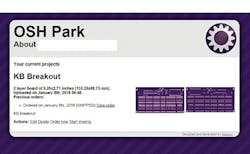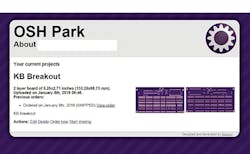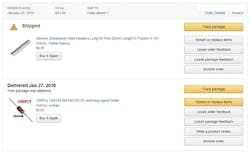From Napkin to Final Product, One PCB Design’s Journey (Part 2)
This file type includes high resolution graphics and schematics when applicable.
Did you miss Part 1? Check it out here.
Finding PCB Manufacturers
Generally, there are two phases of PCB procurement. First, there is the small-quantity, very short lead-time (hopefully) development phase. Then there is the production phase, which usually involves much larger quantities and typically longer lead-times. Other than receiving a reliable product, the requirements of the two phases are usually not the same. It is very likely the board house that produces your prototypes for development will not be the board house that later delivers boards in the thousands for production.
I have worked for organizations that insisted on having me tour the facilities of any fabricator that they were considering for a job. For everything—not just PCBs, but sheet metal, plastic molding, welding, and other things of the like. Here is my opinion on this: I am an engineer, but I am not an expert on the manufacture of all things. And because I am not an expert, I turn to people who are. I am not really qualified to inspect a vendor’s equipment and judge their processes.
The only thing that I am qualified to have an expert opinion about is the final product: the outcome of all their effort. For this reason, I really don’t feel the need to visit facilities, shake hands, and struggle to remember names. I am not against doing it for the sake of learning, but to make it part of the standard operating procedure is really an unnecessary use of time.
By the way, I expect that a lot of people (especially members of the old guard) will disagree with this opinion. They would probably say that building a relationship with these prospective vendors is of paramount importance. Me? I am looking to get a job done. I really don’t want to come off as jaded or cynical here, but experience has taught me that relationships like these develop quite nicely once money starts changing hands.
The situation can be boiled down to three questions for any vendor. The three questions are my method for sourcing almost any custom parts—not just printed circuit boards. Getting those questions answered quickly and making decisions based on that information has been my strategy for making rapid progress over the years.
The three questions:
- Can the vendor do what you need?
- Can the vendor get it to you when you need it?
- How much will it cost?
Let's address the specifics of each of those questions:
Can the vendor do what you need? This is a simple question than can connote a whole lot of excruciating detail. Your project specifications will drive your board design, and your board design will shape this question.
SPEC-->PCB Design-->The Question
Each board house is going to have design preferences, so depending on your project specs, you may have the freedom to adjust the design so that they can do exactly what you need.
Can the vendor get it to you when you need it? Someone in your organization—yourself or the shot-callers you take orders from—are going to set a deadline for having parts in-hand. What kind of lead time (a.k.a., turnaround time) can you put up with? Keep in mind that shorter lead times usually comes at additional expense. Also, larger quantities of product mean a longer manufacturing period, which equals a longer lead time.How much will it cost? Price between manufacturers can vary a lot. Your job is to try to get a minimum acceptable level of quality for the lowest price. There is a compulsion common to engineers, especially the newer ones, to design perfect products made of the best materials. Unchecked, this compulsion would result in titanium-tantalum alloy, gyroscopically leveled coat hangers with SIL 3 failure ratings.
You will have to fight that urge. Maybe you don’t need tolerances as tight as you think. Maybe your board doesn’t need to be that small. After all, smaller boards usually require smaller tools to cut, and smaller tools must be run slower. That takes more time, and manufacturing time costs. Figuring out where you can compromise is how you drive costs down.
Another issue to consider:
The location of the board house. For instance, if the vendor is in China, it is going to be difficult to ship product back and forth quickly. Consider this scenario: Your boards are made in the United States and the organization that assembles and tests your boards is in China. Rather than shipping all of that product back and forth across the globe, it may be more cost-effective to find a single source for all your needs…or at least try to locate the two services on the same continent.
When embarking on a project, you are going to need to manage risk. If a manufacturer’s response to a specific requirement is wishy-washy, or if they can’t commit to the specs that you can’t budge on, move on. This isn’t bad manners, it’s business. You have to ask yourself this question: Can you and/or your organization afford to lose time while a manufacturer “tries” to meet your expectations? The only time “trying” is acceptable is when you are developing something new that hasn’t been done before. Or maybe if the manufacturer is offering a deep discount in exchange for very long lead-times, and you can afford to wait.
There aren't a lot of Yelp reviews for PCB manufacturers ( I checked). So unless you are personally touring the manufacturer’s facilities and have the bona-fides to judge what you see, you will have to rely on word of mouth and forum posts, and maybe the testimonies the board houses themselves post on their websites.
I am leaving out names here, but recently I went with one board house over another because of the images of their work I found on the net. The pictures I found showed that the house I went with produced much cleaner work.
Ordering the parts. I set out to get all the support components I needed: plenty of 0.1-in. spaced pin headers, through-hole diodes, USB sockets, and controller boards.
Pick any electronic parts distributor; they will have what you need (Element14/Premier Farnell, Digikey, Mouser, etc.). For the prototype, I used Amazon. With a smattering of the big parts companies and individuals selling components, I had no issue finding what I needed.
Ah…Amazon Prime two-day shipping, where would I be without you? Most of what I needed could get here in two days. But, one part, a Teensy 2.0 controller board, was a bit harder to find. eBay had a few, some odd sites here and there. In the end, I picked the cheapest one. Above are the diodes I picked, through-hole for ease of assembly. The header pins are from Amazon, too. However, they claimed the position of the plastic break-away pin guides were adjustable; they were not. Either that, or you had to be a monster to move the divider. I left them long.
(Note: I couldn’t find headers I liked that were cheap. I’ll keep searching, for sure.)
I realized that a final product should not use a teensy (or any) dev board. The dev board costs $15. The final version must not hinge completely on finding some discontinued development board. Requiring the user to have to also buy another board is unacceptable. I could mount all the components for the AVR microcontroller onto my board directly, saving about half the price in parts. Even this is too much.
In our next installment, we'll move on to the build itself.
This file type includes high resolution graphics and schematics when applicable.
About the Author
Cabe Atwell
Engineer, Machinist, Maker, Writer. A graduate Electrical Engineer actively plying his expertise in the industry and at his company, Gunhead. When not designing/building, he creates a steady torrent of projects and content in the media world. Many of his projects and articles are online at element14 & SolidSmack, industry-focused work at EETimes & EDN, and offbeat articles at Make Magazine. Currently, you can find him hosting webinars and contributing to Penton’s Electronic Design and Machine Design.




